
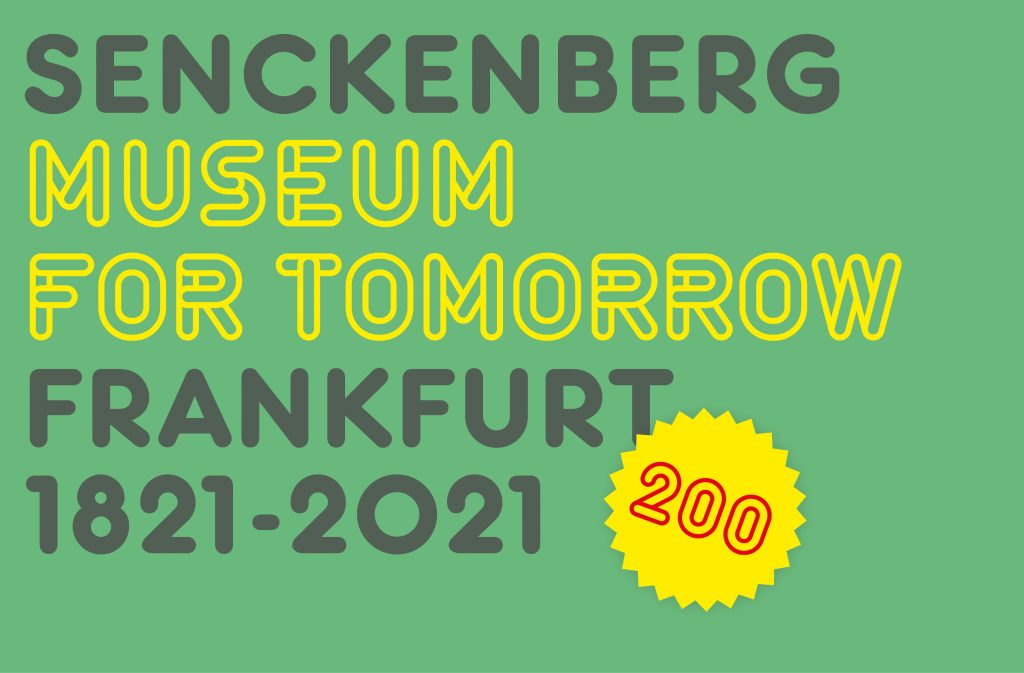
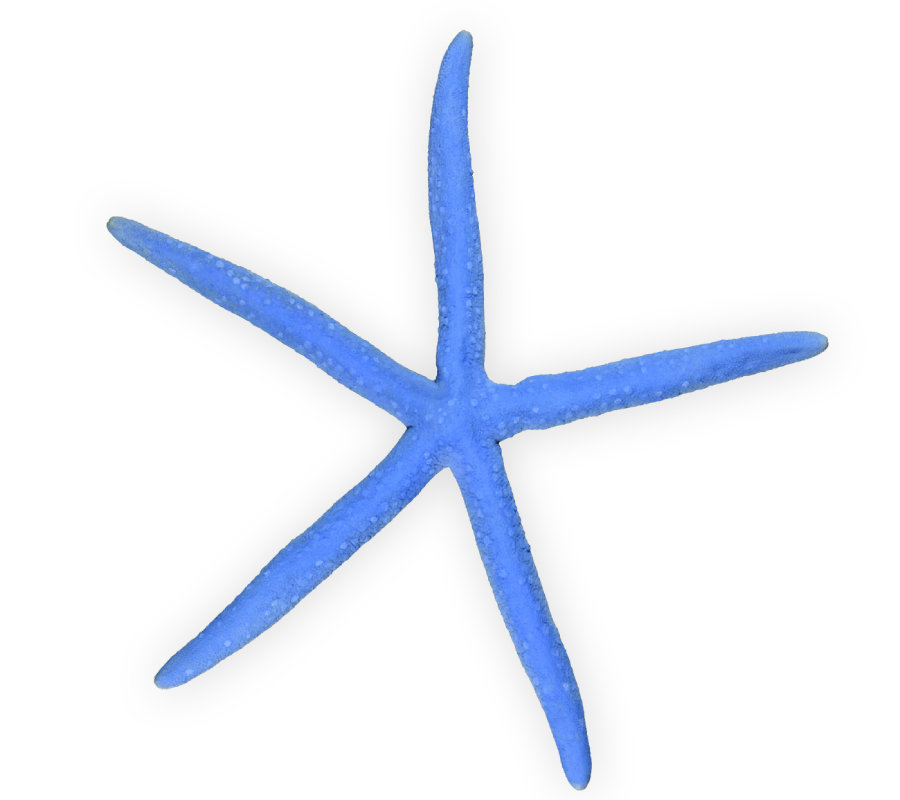
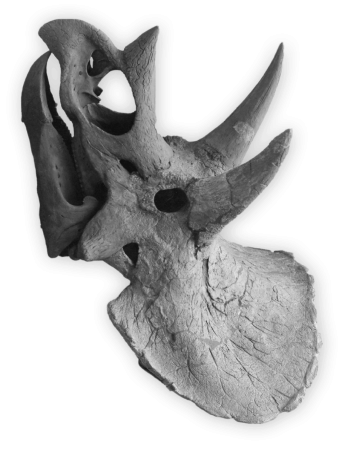
200 years
Senckenberg
Natural History Museum
Frankfurt
The Senckenberg Natural History Museum celebrates its 200th birthday in 2021!
In 1821 – at a time when nature research and research collections are becoming increasingly important – committed citizens create a place for these endeavors. Today, the researchers of the Senckenberg Gesellschaft für Naturforschung (founded in 1817) develop and communicate their findings in seven research institutes, at eleven locations, and in three museums. In addition to the Senckenberg Natural History Museum in Frankfurt, there are two additional museums in Görlitz and Dresden.
»MUSEUM FOR
TOMORROW«
We communicate today’s natural research in a comprehensive way. For example, we make accessible fossils from the distant past and illustrate where and by what means we gain our knowledge about nature. Here, you can check facts eye to eye with dinosaurs and prehistoric horses and learn more about the conditions of life then, now, and in the future, as well as explore them yourself. In the “Museum for Tomorrow,” visitors can discover the history and the present state of the museum and the collections based on 20 selected objects and tell us what their dream museum of the future would look like.
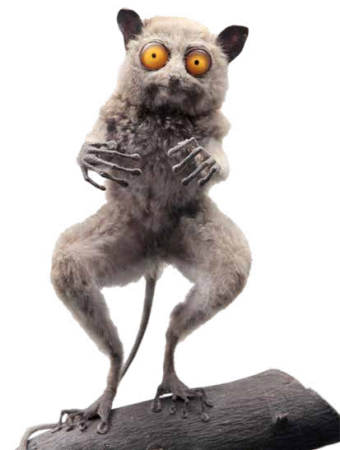
1821
Foundation and opening
On November 21, 1821, the “Museum Senckenbergianum” opens its doors at the Eschenheimer Tor in the heart of downtown Frankfurt near the Zeil. For the first time, the scientific collections are presented there for the members of the Senckenberg Gesellschaft für Naturforschung. Only one year later, all interested citizens are given the opportunity to visit the museum.
1907
New construction
After the old Senckenberg Museum was bursting at the seams, the new building at the current location is inaugurated on October 13, 1907. To mark the occasion, the American Museum of Natural History donates an original skeleton of Diplodocus longus to Senckenberg. To this day, the giant dinosaur can be seen together with numerous other dinosaurs in the museum’s large atrium. The move is accompanied by a new concept: the museum with its display collection and the research institute with its research collection were spatially separated – but to this day, the research sector and the museum still work closely together.
1945
Reopening
World War II brings research almost to a standstill. Researchers and citizens are exposed to the war, are persecuted, or emigrate. Nevertheless, the scientific collections are successfully transferred to 40 locations outside Frankfurt. The museum building is badly damaged. After the end of the war, efforts are concentrated on repairing the building and reestablishing the exhibitions. The museum is able to reopen in the spring of 1949, starting with only the large atrium at first, followed by the first and second floors one year later.
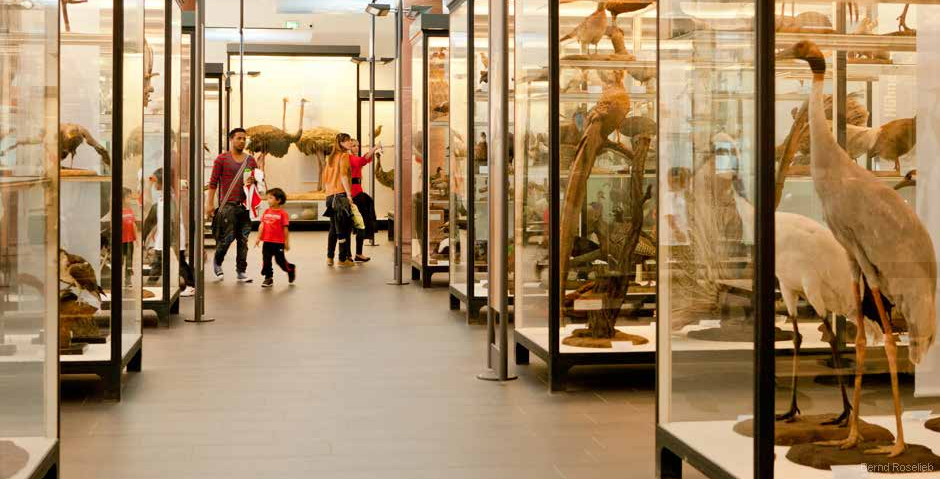
1968
In the late 1960s, the Senckenberg Natural History Museum becomes a leading museum of its kind in western Germany and western Europe. Novel design methods and current environmental protection topics are presented. Young researchers form a new team and contribute their ideas. The exhibition “Environment 2000” in 1970, for example, has a lasting impact, since for the first time, the extinction of species and the need to change our way of life and consumption are publicly presented and discussed.
2021
Anniversary and planning of a conversion and an extension building
The Senckenberg Natural History Museum will be even bigger and more beautiful in the future. To mark its 200th anniversary, the Senckenberg Society is planning the New Senckenberg Museum Frankfurt and intends to expand it over the next 12 years. All topics concerning the relationship between humans and nature will be presented here in an authentic, research-based, and fascinating way. The museum will become an open platform for democratic dialog.
2032
Time leap into the future
The New Senckenberg Museum Frankfurt is open! Well-known “family members” such as Triceratops, Orangutan, and Anaconda are still on display. They show how the museum was once “conceived” and remind us of earlier experiences. At the same time, the house is now an open and dynamic museum space, digitally interconnected and featuring original objects. Current topics regarding nature and research dealing with our future, present, and past are presented and discussed here.

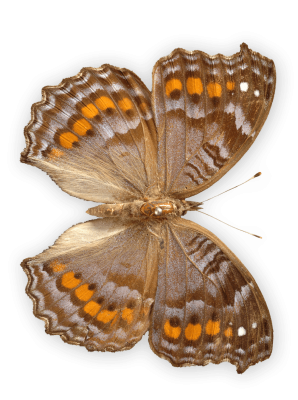
Collectors
With more than 40 million objects, the Senckenberg collections are the most comprehensive natural science collections in Germany, and the fifth-largest worldwide. In addition to the scientists, many collectors and citizens have contributed to the collections until today. Without them, both Senckenberg as an institution and the museum would not exist. Some of the particularly outstanding personalities in this regard include Arthur von Weinberg, Tilly Edinger, Franz Weidenreich, Gustav Heinrich Ralph von Königswald, Gräfin Louise Bose, Eduard Rüppell und Elisabeth Schultz.

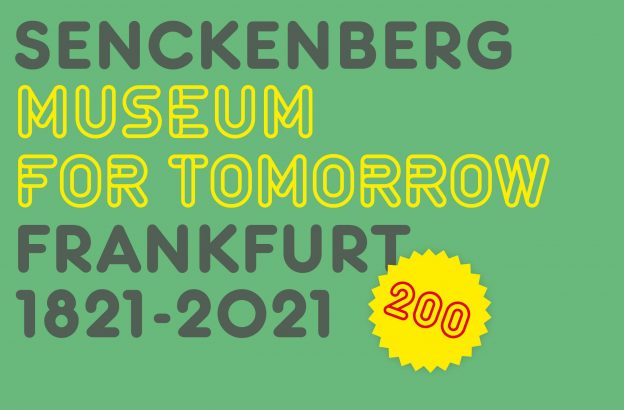

200 years
Senckenberg
Natural History Museum Frankfurt
The Senckenberg Natural History Museum celebrates its 200th birthday in 2021!
In 1821 – at a time when nature research and research collections are becoming increasingly important – committed citizens create a place for these endeavors. Today, the researchers of the Senckenberg Gesellschaft für Naturforschung (founded in 1817) develop and communicate their findings in seven research institutes, at eleven locations, and in three museums. In addition to the Senckenberg Natural History Museum in Frankfurt, there are two additional museums in Görlitz and Dresden.


»MUSEUM FOR
TOMORROW«
We communicate today’s natural research in a comprehensive way. For example, we make accessible fossils from the distant past and illustrate where and by what means we gain our knowledge about nature. Here, you can check facts eye to eye with dinosaurs and prehistoric horses and learn more about the conditions of life then, now, and in the future, as well as explore them yourself. In the “Museum for Tomorrow,” visitors can discover the history and the present state of the museum and the collections based on 20 selected objects and tell us what their dream museum of the future would look like.
1821
Foundation and opening
On November 21, 1821, the “Museum Senckenbergianum” opens its doors at the Eschenheimer Tor in the heart of downtown Frankfurt near the Zeil. For the first time, the scientific collections are presented there for the members of the Senckenberg Gesellschaft für Naturforschung. Only one year later, all interested citizens are given the opportunity to visit the museum.
1907
New construction
After the old Senckenberg Museum was bursting at the seams, the new building at the current location is inaugurated on October 13, 1907. To mark the occasion, the American Museum of Natural History donates an original skeleton of Diplodocus longus to Senckenberg. To this day, the giant dinosaur can be seen together with numerous other dinosaurs in the museum’s large atrium. The move is accompanied by a new concept: the museum with its display collection and the research institute with its research collection were spatially separated – but to this day, the research sector and the museum still work closely together.
1945
Reopening
World War II brings research almost to a standstill. Researchers and citizens are exposed to the war, are persecuted, or emigrate. Nevertheless, the scientific collections are successfully transferred to 40 locations outside Frankfurt. The museum building is badly damaged. After the end of the war, efforts are concentrated on repairing the building and reestablishing the exhibitions. The museum is able to reopen in the spring of 1949, starting with only the large atrium at first, followed by the first and second floors one year later.
1968
In the late 1960s, the Senckenberg Natural History Museum becomes a leading museum of its kind in western Germany and western Europe. Novel design methods and current environmental protection topics are presented. Young researchers form a new team and contribute their ideas. The exhibition “Environment 2000” in 1970, for example, has a lasting impact, since for the first time, the extinction of species and the need to change our way of life and consumption are publicly presented and discussed.
2021
Anniversary and planning of a conversion and an extension building
The Senckenberg Natural History Museum will be even bigger and more beautiful in the future. To mark its 200th anniversary, the Senckenberg Society is planning the New Senckenberg Museum Frankfurt and intends to expand it over the next 12 years. All topics concerning the relationship between humans and nature will be presented here in an authentic, research-based, and fascinating way. The museum will become an open platform for democratic dialog.
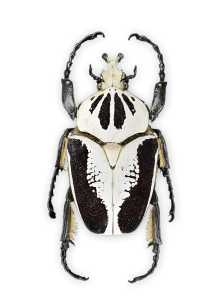
2032
Time leap into the future
The New Senckenberg Museum Frankfurt is open! Well-known “family members” such as Triceratops, Orangutan, and Anaconda are still on display. They show how the museum was once “conceived” and remind us of earlier experiences. At the same time, the house is now an open and dynamic museum space, digitally interconnected and featuring original objects. Current topics regarding nature and research dealing with our future, present, and past are presented and discussed here.
Collectors
With more than 40 million objects, the Senckenberg collections are the most comprehensive natural science collections in Germany, and the fifth-largest worldwide. In addition to the scientists, many collectors and citizens have contributed to the collections until today. Without them, both Senckenberg as an institution and the museum would not exist. Some of the particularly outstanding personalities in this regard include Arthur von Weinberg, Tilly Edinger, Franz Weidenreich, Gustav Heinrich Ralph von Königswald, Gräfin Louise Bose, Eduard Rüppell und Elisabeth Schultz.
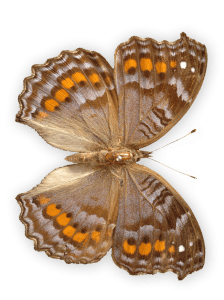

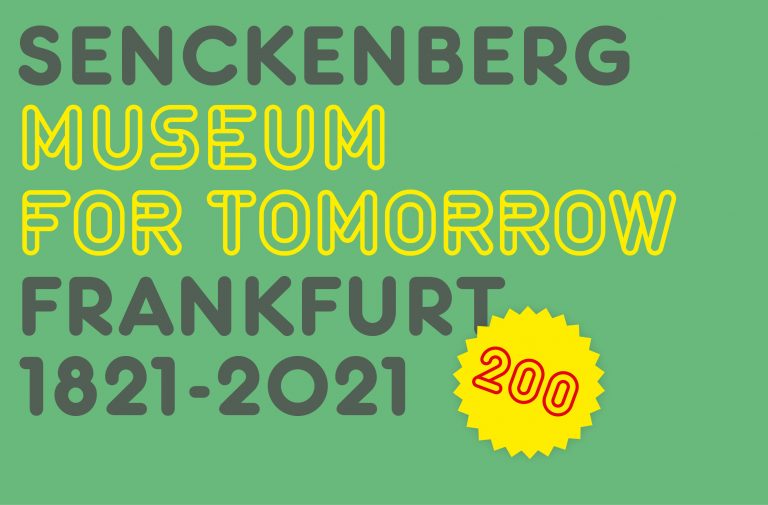

200 years Senckenberg Natural History Museum Frankfurt
The Senckenberg Natural History Museum celebrates its 200th birthday in 2021!
In 1821 – at a time when nature research and research collections are becoming increasingly important – committed citizens create a place for these endeavors. Today, the researchers of the Senckenberg Gesellschaft für Naturforschung (founded in 1817) develop and communicate their findings in seven research institutes, at eleven locations, and in three museums. In addition to the Senckenberg Natural History Museum in Frankfurt, there are two additional museums in Görlitz and Dresden.

»MUSEUM FOR TOMORROW«
We communicate today’s natural research in a comprehensive way. For example, we make accessible fossils from the distant past and illustrate where and by what means we gain our knowledge about nature. Here, you can check facts eye to eye with dinosaurs and prehistoric horses and learn more about the conditions of life then, now, and in the future, as well as explore them yourself. In the “Museum for Tomorrow,” visitors can discover the history and the present state of the museum and the collections based on 20 selected objects and tell us what their dream museum of the future would look like.

1821
Foundation and opening
On November 21, 1821, the “Museum Senckenbergianum” opens its doors at the Eschenheimer Tor in the heart of downtown Frankfurt near the Zeil. For the first time, the scientific collections are presented there for the members of the Senckenberg Gesellschaft für Naturforschung. Only one year later, all interested citizens are given the opportunity to visit the museum.
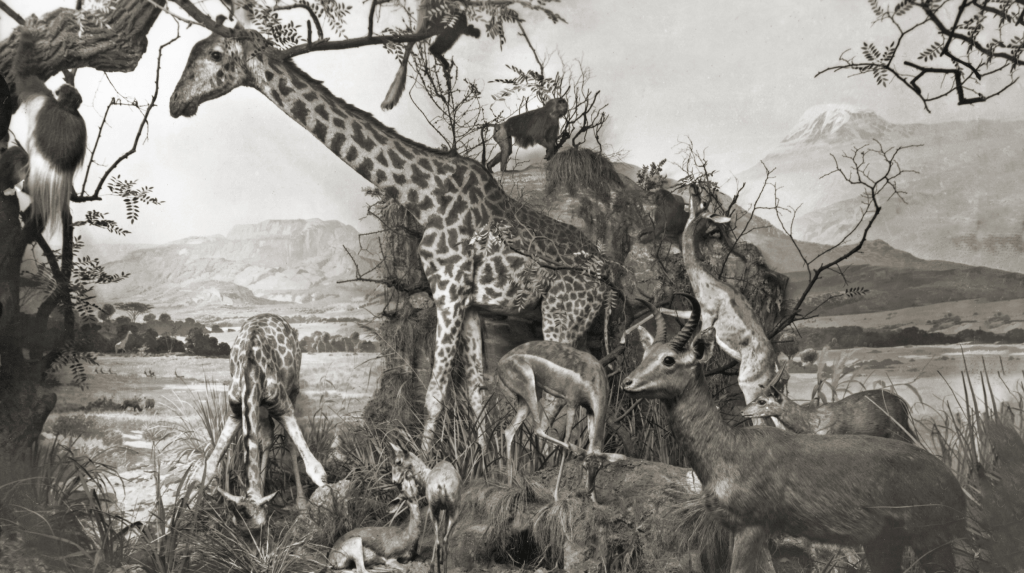
1907
New construction
After the old Senckenberg Museum was bursting at the seams, the new building at the current location is inaugurated on October 13, 1907. To mark the occasion, the American Museum of Natural History donates an original skeleton of Diplodocus longus to Senckenberg. To this day, the giant dinosaur can be seen together with numerous other dinosaurs in the museum’s large atrium. The move is accompanied by a new concept: the museum with its display collection and the research institute with its research collection were spatially separated – but to this day, the research sector and the museum still work closely together.
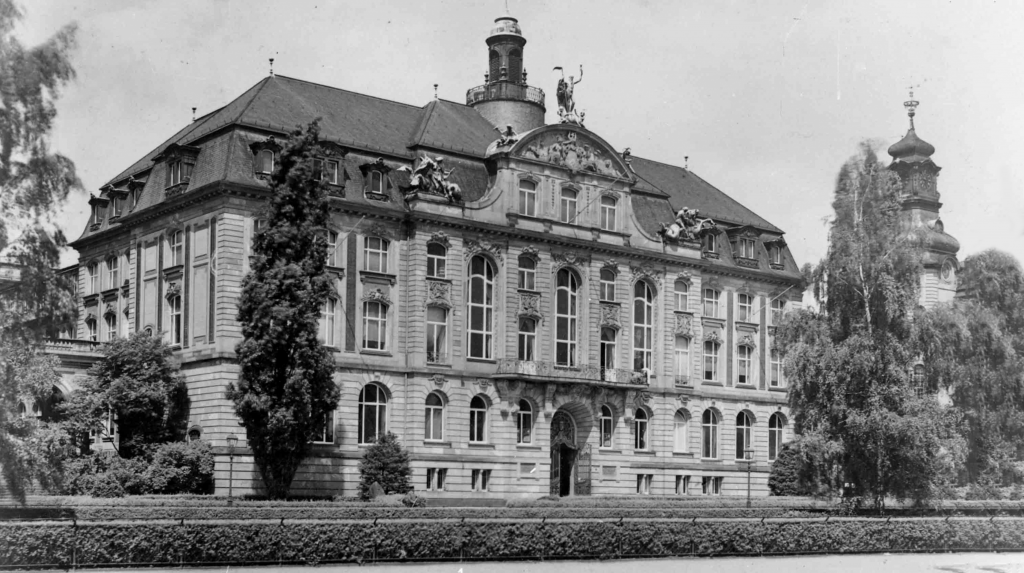
1945
Reopening
World War II brings research almost to a standstill. Researchers and citizens are exposed to the war, are persecuted, or emigrate. Nevertheless, the scientific collections are successfully transferred to 40 locations outside Frankfurt. The museum building is badly damaged. After the end of the war, efforts are concentrated on repairing the building and reestablishing the exhibitions. The museum is able to reopen in the spring of 1949, starting with only the large atrium at first, followed by the first and second floors one year later.
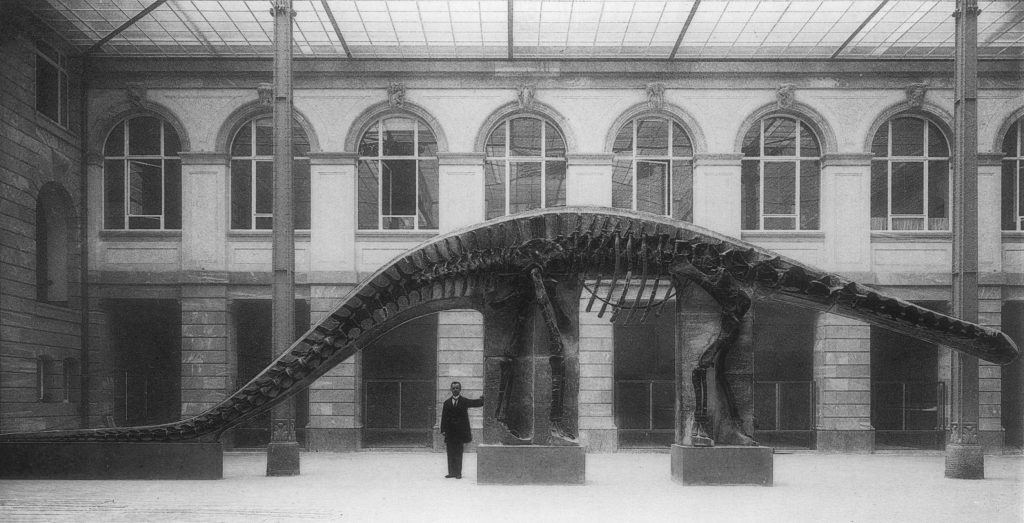
1968
In the late 1960s, the Senckenberg Natural History Museum becomes a leading museum of its kind in western Germany and western Europe. Novel design methods and current environmental protection topics are presented. Young researchers form a new team and contribute their ideas. The exhibition “Environment 2000” in 1970, for example, has a lasting impact, since for the first time, the extinction of species and the need to change our way of life and consumption are publicly presented and discussed.

2021
Anniversary and planning of a conversion and an extension building
The Senckenberg Natural History Museum will be even bigger and more beautiful in the future. To mark its 200th anniversary, the Senckenberg Society is planning the New Senckenberg Museum Frankfurt and intends to expand it over the next 12 years. All topics concerning the relationship between humans and nature will be presented here in an authentic, research-based, and fascinating way. The museum will become an open platform for democratic dialog.
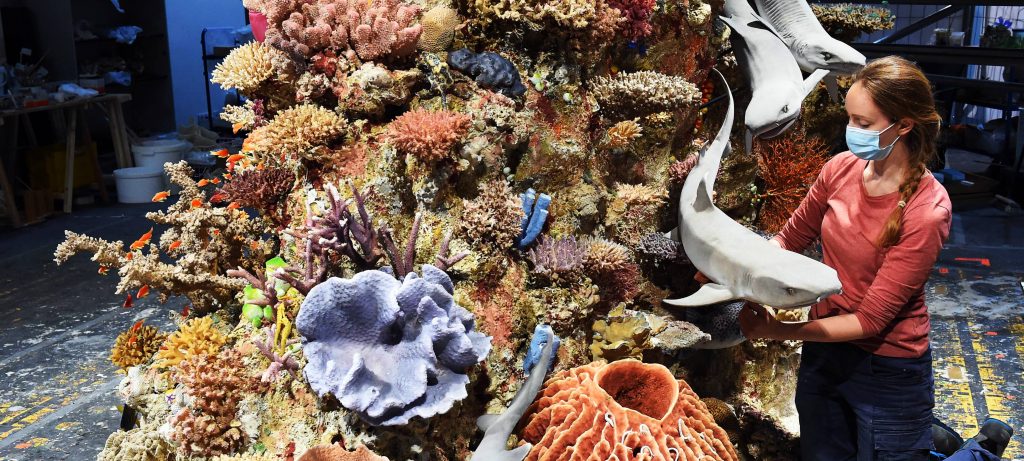
2032
Time leap into the future
The New Senckenberg Museum Frankfurt is open! Well-known “family members” such as Triceratops, Orangutan, and Anaconda are still on display. They show how the museum was once “conceived” and remind us of earlier experiences. At the same time, the house is now an open and dynamic museum space, digitally interconnected and featuring original objects. Current topics regarding nature and research dealing with our future, present, and past are presented and discussed here.
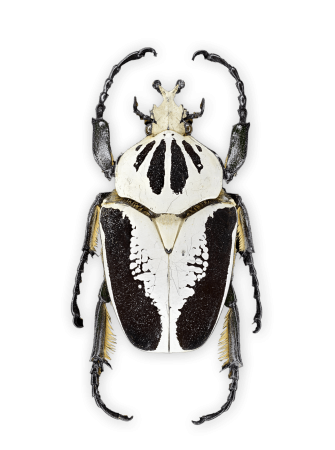
Collectors
With more than 40 million objects, the Senckenberg collections are the most comprehensive natural science collections in Germany, and the fifth-largest worldwide. In addition to the scientists, many collectors and citizens have contributed to the collections until today. Without them, both Senckenberg as an institution and the museum would not exist. Some of the particularly outstanding personalities in this regard include Arthur von Weinberg, Tilly Edinger, Franz Weidenreich, Gustav Heinrich Ralph von Königswald, Gräfin Louise Bose, Eduard Rüppell und Elisabeth Schultz.
